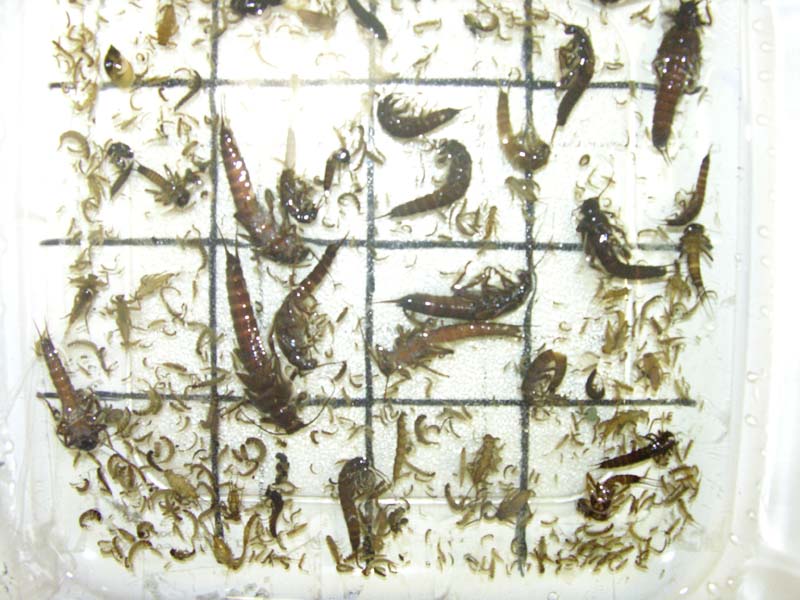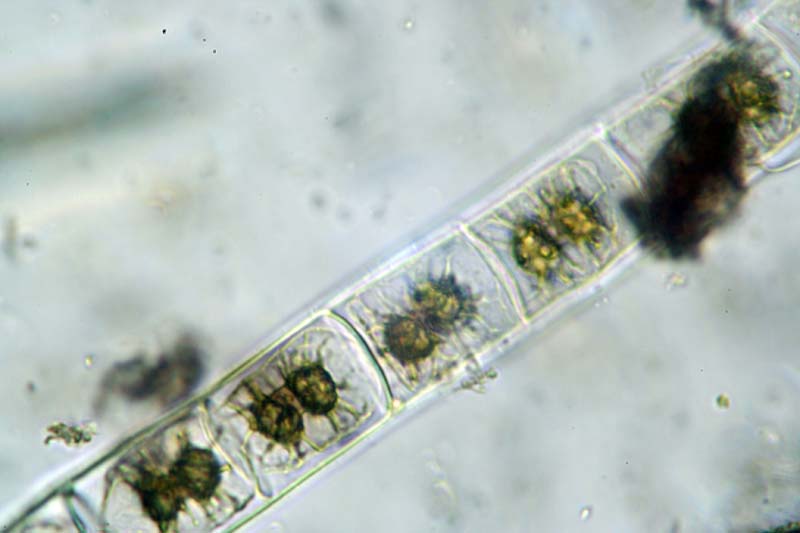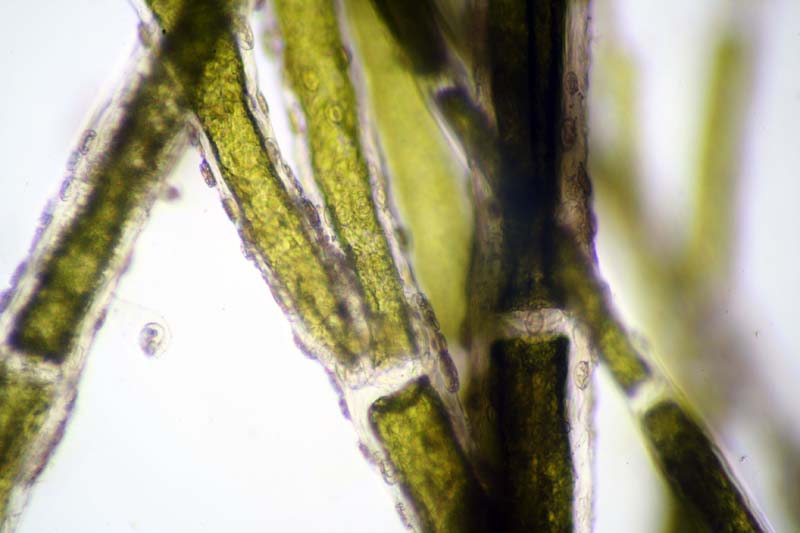EcoAnalysts: Life in Water Frequently, we post a mystery macro invertebrate to our website as part of an ongoing contest that challenges website visitors to identify a digitally captured microscopic image to the highest taxonomic resolution. The person who e-mails the correct answer receives a prize, and those who identify the most macro invertebrates in a year win a grand prize. Often the winners are macro invertebrate taxonomy experts, marine taxonomy students, or professors in the field.
Of course, our staff has already identified the mystery macro invertebrate. It's what we do. Accurate and timely taxonomic identification of macro invertebrate samples, biological assessment, and consulting services have been our core capabilities for nearly two decades.

When the U.S. Environmental Protection Agency (EPA) needs a laboratory that can handle the volume of taxonomy samples generated by its National Coastal Condition Assessment (NCCA), which can generate up to 1,200 benthic invertebrate samples annually, there aren't a lot of options. The sheer size and scope of analysis needed for this ongoing project requires a reliable company that can provide both world-class technical excellence and high throughput capacity at a reasonable fee.
In fact, since 2010, when it comes to the NCCA such stringent requirements have narrowed the competition down to just one company: EcoAnalysts, Inc. For larger taxonomy projects in the United States and Canada, EcoAnalysts represents a unique set of capabilities that can only be matched by enlisting multiple smaller laboratories, which inherently creates issues concerning taxonomic consistency and data quality.

But capabilities only tell half the story. The level of excellence that EcoAnalysts brings to vital large-scale projects, both from technical service and relationship management aspects, has earned the trust and respect of multiple clients, particularly the EPA.
At EcoAnalysts, Inc., we run a lean corporation. Most of our employees (around 45 of the 60) spend each day examining and identifying organisms through a microscope. Many have advanced degrees and often specialize in a particular taxonomic area, such as invertebrates, marine polychaetes, chironomids, diatoms, crustaceans, and so forth.

Since we encounter samples from a variety of habitats and regions around the globe, our taxonomists frequently encounter species that are either new to science or represent signification range extension. Occasionally, our clients permit us to publish the new species descriptions or range extensions in peer-reviewed literature. EcoAnalysts' staff is proud to contribute to the body of scientific knowledge when we are able to do so. These contributions include providing reliable raw data to projects like the NCCA.
About The 2015 National Coastal Condition Assessment
In 2010, EcoAnalysts, Inc. was awarded a contract by the EPA (through a partnership with Cadmus Group) to analyze samples collected from the nation’s coasts in an effort to monitor and evaluate the ecological and environmental conditions in U.S. coastal waters as part of the 2010 NCCA. Under this project, EcoAnalysts processed estuarine and coastal benthic macro invertebrate samples collected by partners and provided taxonomic identification of the organisms that inhabit the bottom substrates of water bodies. Samples were collected from approximately 1,000 stations along the coasts of the continental United States, including the Pacific, Atlantic, and Gulf Coast, and from hundreds of stations in the Great Lakes.
Due to its demonstrated expertise, EcoAnalysts also won an award for the upcoming 2015 NCCA. The firm will start receiving samples from the Great Lakes in fall 2014 from approximately 50 sites, and in 2015 the coastal sampling begins.
The 2015 NCCA builds on previous efforts to determine the ecological integrity and recreational quality of the nation’s coasts, track trends/changes to evaluate progress in improving water quality, promote collaboration across jurisdictional boundaries, and build state and tribal capacity for monitoring and analyses. The goals of the NCCA are to address two key questions about the quality of the Nation’s coastal waters: 1) What percent of the Nation’s coastal waters are in good, fair, and poor condition for key indicators of water quality, ecological health, and recreation?; and 2) What is the relative importance of key stressors such as nutrients and contaminated sediments?
The sampling design is a probability-based network that will provide statistically valid estimates of the condition of all coastal waters with known confidence. It is designed using modern survey techniques. Sample sites are selected at random to represent the condition of all coastal waters across each region and the nation as a whole. About half of the sample sites for this iteration of the assessment are from new locations that were not sampled in 2010. The samples are gathered by federal, state, tribal, and contract field crews using boats. They are preserved in formalin in the field, staged with a contract project manager, then shipped via FedEx to EcoAnalysts' taxonomy laboratory in Moscow, Idaho for sorting, identification, and enumeration of the benthic infaunal community.
For NCCA 2015, project deliverables will be:
1) A full sort and identification of benthic infauna to lowest practical taxonomy level. Usually this is at a resolution of genus/species.
2) An organized database containing taxa lists, counts, IDs and all associated metadata provided to us by the client.

Sample Design Description per the EPA Office of Water
Target population: All coastal waters of the United States, from the head-of-salt to confluence with ocean including inland waterways and major embayments such as Florida Bay and Cape Cod Bay.
Sample Frame: The sample frame was derived from a previous National Coastal Assessment sample frame developed by ORD Gulf Breeze Ecology Division. The prior GED sample frame was enhanced as part of the National Coastal Monitoring Network design by including information from NOAA’s Coastal Assessment Framework, boundaries of National Estuary Programs, and identification of major coastal systems.
Survey Design: A Generalized Random Tessellation Stratified (GRTS) survey design for an area resource is used. The survey design is a stratified design with unequal probability of selection based on area within each stratum. The details are given below.
Stratification: Stratification is based on major estuaries based on the NOAA Coastal Assessment framework and NEP estuaries.
Multi-density categories: Unequal probability categories were created based on area of polygons within each major estuary. The number of categories ranged from three to seven. The categories were used to ensure that sites were selected in the smaller polygons.
Panels: Design includes three panels: 1) Revisit: identifies sites that are to be visited twice; 2) Base: identifies remaining sites to be visited; and 3) Over: identifies sites available to be used as replacement sites. Over sample sites were selected independent of the other two panels.
Expected sample size: Expected sample size is 682 sites for conterminous coastal states and 45 sites for Hawaii and Puerto Rico. The maximum number of sites for a major estuary was 46 (Chesapeake Bay). Total number of site visits allocated is 750 (682 unique sites and 68 sites to be revisited).
Over sample: Over sample size was selected to provide replacement sites that either are not part of the target population or could not be sampled as well as to accommodate those states on National Estuary Programs that may want to increase the number of sites sampled within their state for a state-level design or NEP design.
Site Use: Sites should be used in SiteID order within each major estuary group or, if enhancing for state or NEP design, by SiteID order within state or NEP. If a revisit site cannot be sampled, the next site in the Base panel within the major estuary group should be used as revisit site.
Evaluation Process: The survey design weights that are given in the design file assume that the survey design is implemented as designed. Typically, users prefer to replace sites that cannot be sampled with other sites to achieve the sample size planned. The site replacement process is described above. When sites are replaced, the survey design weights are no longer correct and must be adjusted. The weight adjustment requires knowing what happened to each site in the base design and the over sample sites. EvalStatus is initially set to “NotEval” to indicate that the site has yet to be evaluated for sampling. When a site is evaluated for sampling, then the EvalStatus for the site must be changed.
The following table shows sample EvalStatus codes and their associated meanings:

Statistical Analysis
Any statistical analysis of data must incorporate information about the monitoring survey design. In particular, when estimates of characteristics for the entire target population are computed, the statistical analysis must account for any stratification or unequal probability selection in the design. Procedures for doing this are made available from the EPA Office of Water at www.epa.gov/nheerl/arm/. The site provides information on the monitoring of aquatic resources in the U.S., primarily focused on design and analysis of probability based surveys. Links are also provided to other aquatic resources monitoring information available on the Internet.
Survey Data and Reports Publicly Available
NCCA is one of a series of water surveys being conducted by states, tribes, the EPA, and other partners. In addition to coasts, partners also study lakes, reservoirs, wadeable streams, rivers, and wetlands in a revolving sequence. The purpose of these conglomerated surveys is to generate statistically valid and environmentally relevant reports on the condition of the nation’s water resources.
The resulting EPA reports on each survey provide a statistically valid assessment of the condition of our nation's water-bodies, by type (lakes, rivers/streams, wetlands, coasts). They typically summarize the results by identifying using percentage which waterbodies are non-impaired, moderately impaired, severely impaired. The reports are available online at water.epa.gov.
Data used to develop the National Coastal Condition Reports I-IV are available from the Environmental Monitoring and Assessment Program website at www.epa.gov/emap. Data used to develop the NCCA 2010 Report will be accessible from this webpage by late 2014.
It is expected that the 2015 NCCA study will greatly inform the U.S. National Policy for the stewardship of the ocean, our coasts, and the Great Lakes. This initiative and any offshore projects that are required to look at benthic infauna, epifauna, zooplankton, phytoplankton, or ichthyoplankton communities are all candidate projects to which EcoAnalysts can lend our taxonomic expertise and that will help our clients make informed decisions regarding the condition of our Great Lakes, coastal, and oceanic environments. These projects could include offshore infrastructure, energy, undersea mining, marine outfalls, pipeline, telecomm, etc.
What is Next for EcoAnalysts?
EcoAnalysts continues to strengthen and grow the technical expertise of our company to continue providing high-quality biological data for the decision-making purposes of our clients. We are also working hard at strengthening our organizational structure and business systems in order to operate more efficiently and make better business operating decisions. This is challenging for a team of scientists! Demand for our marine services has grown tremendously and continues to grow as more people become aware of us around the world.
From a market standpoint, there is a growing demand for taxonomic identification services while there is a corresponding decline in the number of people interested in providing taxonomic identifications. The university systems have largely moved away from traditional morphological taxonomy, which is still very much in demand. As a result, EcoAnalysts is using its role in the marketplace to step in and train young people in the art and science of taxonomy, thereby ensuring taxonomic expertise is being passed down to younger generations.

EcoAnalysts is a privately owned, science-driven company that focuses exclusively on the use of biological communities as indicators of environmental quality. Founded in 1995, the company has grown to become North America's largest taxonomy services provider, with over 60 staff involved in all aspects of aquatic biological monitoring studies. With its roots in freshwater benthic ecology, the company has diversified into a one-stop taxonomy shop, with services now including benthic invertebrates, algae (periphyton/phytoplankton), zooplankton, and fish communities in both freshwater and marine environments. EcoAnalysts' marine services laboratory has acquired projects around the globe, greatly expanding the company's project footprint.
For 2015 (the most recent NCCA award), EcoAnalysts is subcontracting to PG Environmental, LLC out of Herndon, Virginia, a water resources firm offering specialized technical expertise to federal and state agencies tasked with protecting and restoring our nation’s valuable water resources. PG Environmental is one of two prime contract holders who provide technical support to the EPA for the National Aquatic Resource Surveys. For information on EcoAnalysts, Inc., visit www.ecoanalysts.com.




